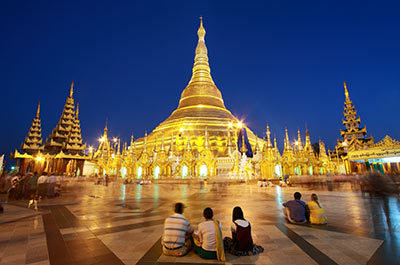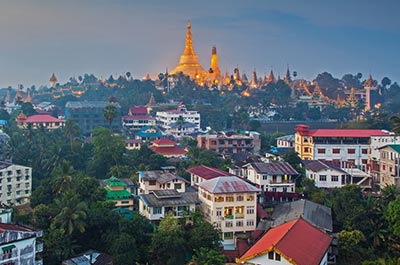
Colonial era buildings
Late 19th century British architecture in Yangon
Of all South East Asian cities, Yangon has the highest number of colonial era buildings. Hundreds of late 19th century structures remain on an area of several square miles in the downtown area.
Majestic buildings in various styles
In 1852 the British seized much of Burma including Yangon and made the city the Burmese capital in 1885. They constructed a great number of grand, impressive, majestic buildings in Victorian, Queen Anne, Art Deco, British Burmese and Neoclassical style.
As a result of Burma’s isolation the city remained much like it was since the end of the 19th century. The old business district near the river still looks much like it did a century ago.
After the Burmese government moved the capital to Naypyidaw in 2005 many of the colonial era buildings were abandoned and are now in a bad state of repair. Since Burma has slowly opened up to tourism and foreign investment, hundreds of colonial era buildings have been destroyed and replaced by modern high rise buildings, shopping malls and hotels.
Yangon City Heritage List
In order to protect Yangon’s remaining historical buildings the Burmese government has instated the Yangon City Heritage List. The list contains a large number of historical buildings, mostly schools and government buildings from the British colonial era as well as temples and pagodas that cannot be demolished or modified without approval. Recently a moratorium was established, that forbids demolition of all buildings older than 50 years.
The Secretariat or Ministers Office
The Secretariat or Ministers Office, a massive red and yellow brick complex constructed in a U-shape, was build towards the end of the 19th century. The Victorian style building served as the seat of British rule during the colonial era until Burma’s independence in 1948.
The towers on two of the four corner buildings as well as the imposing central dome collapsed during a severe earthquake in the 1930’s and have not been rebuild. The building is vacant since the government was moved to the new capital Naypyidaw. Plans exist to restore it and turn it into a hotel or museum.
The Secretariat building is located between Anawratha road and Maha Bandula road in downtown Yangon, about one kilometer South East of Yangon central railway station and 600 meters East of the Sule pagoda.

Strand hotel
One of Yangon’s best restored colonial era buildings, the Strand hotel faces the Yangon river in the center of town.
The Victorian style building opened its doors in 1901 and was one of Asia’s most luxurious hotels during colonial days. After Burma had regained its independence the hotel was neglected and several decades later the building was in a poor state of repair. It was restored in the 1990’s in its original design. The hotel reopened in 1993 and is now one of the most luxurious and expensive hotels in Burma.
The Strand hotel is located on Strand road facing the Yangon river, about one kilometer South East of the Sule pagoda.
Yangon city hall
Located in the downtown area, Yangon city hall is an impressive Burmese style building with tiered roofs called Pyatthat, topped with hti, a ceremonial umbrella. Flanking the arched entrance are two Nagas, serpents from Buddhist and Hindu mythology, guarding the hall. The building was completed in 1936 after 10 years of construction.
Yangon city hall is located on Maha Bandula road, next to the Sule pagoda.
High court building
The high court building is a huge red and yellow brick building in the center of Yangon. The impressive square structure encloses a courtyard. A grand clock tower faces Independence Monument. The Queen Anne style building was constructed by the British in 1911 and served as the seat of the high court during British colonial rule. The high court was recently moved to the new capital Naypyidaw.
The high court building is located 200 meters East of the Sule pagoda between Merchant road and Maha Bandula road.

Other colonial era buildings
A few of the many other worthwhile colonial era buildings include the Yangon region court building on Strand road, the Central Telephone & Telegraph office on Maha Bandula road, the Custom House on Strand road, the Bogyoke Aung San Museum on Bo Gyoke Museum Lane, the Yangon central railway station on Bo Gyoke road and the Myanmar Port Authority building on the intersection of Pansodan street and Strand road.
Also in Yangon:







